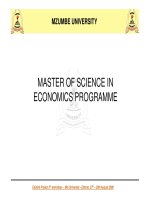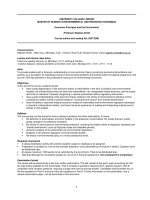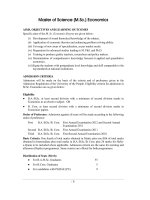UNIVERSITY COLLEGE LONDON MASTER OF SCIENCE IN ENVIRONMENTAL AND RESOURCE ECONOMICS pdf
Bạn đang xem bản rút gọn của tài liệu. Xem và tải ngay bản đầy đủ của tài liệu tại đây (57.12 KB, 12 trang )
UNIVERSITY COLLEGE LONDON
MASTER OF SCIENCE IN ENVIRONMENTAL AND RESOURCE ECONOMICS
Economic Principles and the Environment
Professor Stephen Smith
Course outline and reading list, 2007/2008
Course lecturer
Stephen Smith. Office hour: Mondays, 3.30 - 4.30 pm. Room 3.27 Drayton House. email:
Lecture and tutorial class times
9 two-hour weekly lectures, on Mondays, 10-12, starting 8 October.
4 tutorial classes to discuss problems and written work, 4pm, Mondays 6/11, 13/11, 27/11, 11/12
Aims
To provide students with a thorough understanding of core economic theory concerning environmental problems and
policies, as a foundation for subsequent study of environmental problems and policies within the degree programme, and
as one of the key elements in the professional training of an environmental economist.
Objectives
At the end of the course, students should:
•
have a good appreciation of the economic theory of externalities in the form of pollution and environmental
hazards, the market failures that can arise from externalities in an unregulated market economy, and the scope
and limits of individual "Coasean" bargaining to resolve externalities without regulatory intervention;
•
have a good understanding of the economic theory relating to the choice of instruments for pollution control,
including the relative merits of policies based on "command-and-control" and "market mechanisms";
•
have the ability to read and interpret economic models of externalities and environmental regulation expressed
in standard mathematical notation, and have had some experience of reading and interpreting original journal
articles on this subject.
Syllabus
This course sets out the economic theory relating to pollution and other externalities. It covers:
•
the definition of externalities, economic welfare in the presence of externalities, the Coase theorem, public
goods, problems of preference revelation;
•
the choice of instruments for environmental protection, including the relative merits of regulatory standards and
"market mechanisms" such as Pigouvian taxes and tradeable permits;
•
economic analysis of the enforcement of environmental regulations;
•
problems in the efficient regulation of environmental hazards
•
the theory of environmental policy in a multi-jurisdictional world.
Required coursework
•
A class presentation (jointly with another student), based on readings to be assigned
•
Preparation of answers to a set of short-answer questions, to be submitted by the lecture in week 8. Question set to
be distributed later.
•
An essay (maximum 1500 words) to be submitted by the end of term. Titles to be distributed later.
•
Note that although the coursework grades do not count in the final assessment, the coursework is compulsory.
Examination format
The course will be examined by a two-hour written examination. This will consist of two parts, each accounting for half
the total marks available for the examination. Part A consists of questions requiring short, specific answers. Part B
comprises more complex questions, requiring a longer and more structured answer. Candidates should answer four of
the five questions in Part A, and one of the four questions in Part B. Further information on the examination, and a
sample examination paper, can be found later in this document.
1
Introduction
This course outline tries to give a brief flavour of the material which will be covered in the course, highlighting the
debates and issues which the course addresses. Although the course is a theory course, the selection of the material to
be covered aims, as far as possible, to concentrate on theory which will be useful in understanding policy debates. Many
of the issues studied in this course will reappear in other parts of the degree programme (for example in the policy
courses on "European Environmental Policy", "Global Environmental Problems" and "Environment and Development" in
the second term).
The function of this course is to equip you with an understanding of the theory which underpins these policy issues, and
with the ability to read and interpret theoretical papers in this field. The course therefore makes considerable use of
formal theory and notation. Although it is most important that you should understand the intuition behind the theoretical
models (the "essence" of the argument), it is also important that you should feel comfortable with the way in which
theoretical models are expressed.
Reading
Much of the reading list consists of journal articles, making key advances in the theoretical literature. You should try to
read these carefully, at least one or two a week, in parallel with the course. You may not find this easy. Some of them,
for example, make references to other papers which you will not have read, or presume familiarity with a debate which
was current at the time when they were written. However, you will find some of the other readings helpful in providing
explanations or alternative formulations of the arguments. You should not expect to understand everything at first
reading, and you will probably find that if you re-read the first papers after you have finished the course as a whole that
you understand much more than you did the first time.
Also, if you have not read original economic theory papers before (or indeed, if you have not done much economics
before), you may find these papers quite a shock. Don't be unduly alarmed, and don't let yourself get stuck for too long
with a paper that you can't understand. Move on to something else, and come back to it after a few weeks; you'll often
find that what you have learned in the meantime has helped to make sense of the paper.
Textbooks
The textbook for this course is:
Charles D Kolstad, Environmental Economics, Oxford University Press, 2000.
Chapters 1 to 12 of this book provide a good introduction to the topics covered in this lecture course. The book is not
highly-mathematical, although mathematical notation is used where it helps to make things clearer. I like the book, and
have chosen to adopt it as a textbook because it provides clear explanations of the intuition behind the theoretical
models discussed. It is rigorous and precise in its analysis, without overcomplicating things that can be explained
straightforwardly and simply. It also covers important issues, such as audit, enforcement, and the regulation of hazards,
which are neglected in most other environmental economics textbooks.
In earlier years when I have taught this course the textbook used was:
W J Baumol and W E Oates, The Theory of Environmental Policy, Second Edition, Cambridge University Press,
Cambridge 1988.
This is more formal and mathematical than Kolstad, and more limited in scope (it has nothing on hazards or
enforcement, for example). In many places, it isn't so much a textbook as a compilation of the authors' own papers, and
it feels, to my mind, rather unbalanced in the coverage it gives to different topics. However, it has been written by two of
the great scholars in this field, and you may find it useful as a supplement for Kolstad on certain topics (and, in some
cases, as a bridge between the relatively accessible analysis in Kolstad and the more technical presentation of academic
journal articles).
If you find Kolstad, Baumol and Oates and the recommended journal papers too heavy going, there are a number of
other rather less technically-demanding textbooks which you may find useful, especially at the start of the course. You
2
might, for example, try:
Perman, R., Y. Ma, J. McGilvray and M Common (2003), Natural Resource and Environmental Economics,
Harlow: Longman. (Chapters 5-8 are the most relevant for this course)
Hanley, N, JF Shogren, and B White, (1997), Environmental Economics in Theory and Practice, London:
Macmillan. (Chapters 2 - 6 are the most relevant to this course)
However, don't be tempted to rely on these less-technical books and nothing else. You do need to be able to master the
material in Kolstad by the end of the course, and you do need to be reasonably familiar with the notation and methods
which the theoretical papers use.
To begin with...
An overview of many of the issues covered in this course (and also of some issues addressed in next term's course on
Techniques of Environmental Valuation) is given in:
Cropper, M. L. and W. E. Oates (1992), "Environmental Economics: A Survey", Journal of Economic Literature,
Vol XXX, pp 675-740.
Lecture schedule
Week
3
4.
5.
6.
8.
9.
10.
11.
12.
Introduction: market failure and externalities
Optimal pollution abatement and the Coase Theorem
Public goods: Information and preference revelation
Market mechanisms versus Command and Control
[Reading week - week 7]
Uncertainty and Instrument Choice
The Pigovian Tax: Further topics
Regulatory compliance and enforcement
Hazards
Inter-jurisdictional issues
Tutorial class schedule
Week
5
8
10
12
23 October
13 November
27 November
11 December
The Coase Theorem
Efficiency: Market mechanisms versus Command-and-Control
Emissions trading
Regulation of environmental hazards
Coursework and tutorial class instructions to follow
3
Topic 1.
Externalities and Public Goods
In economic analysis of environmental policy, a central role is played by the concept of an externality. A large number of
environmental problems involve externalities - including the human health effects from lead emissions by motor vehicles,
the nuisance caused to local residents by aircraft noise at airports, the various social and economic consequences of
climate change due to "greenhouse gas" emissions, etc. We will start by defining the concept of an externality.
If there are no externalities present, and given certain other conditions, an unregulated, perfectly-competitive market
economy may achieve the socially-optimal ("efficient") outcome. If externalities are present, however, the outcome from
an unregulated market economy may fall short of the social optimum. We will consider the meaning of these claims, and
set out a formal model in which an externality leads to an inefficient, sub-optimal, outcome. We will then go on to
consider some cases where an efficient solution might be possible even where externalities are present.
The problems arising from externalities are closely linked to the definition of "property rights". A key paper by Coase
(1960) argues that bargaining between individuals will achieve efficient solutions to externality-type problems, if property
rights are clearly defined. We will consider the circumstances in which the "Coase theorem" holds, and will introduce
some of the problems which arise with bargaining solutions when many individuals are involved. A key idea here is the
idea of the "prisoner's dilemma" - even though it may be in everyone's interest that cooperation should take place (for
example to get together to bribe a local polluter to stop polluting), it may be in no-one's individual interest to cooperate
(everyone may do better by trying to "free ride" on the collective actions of others, without contributing anything
themselves).
This leads us to think more generally about the problems of information which arise when externalities are present. If
individuals try to "free ride", how do we know how much environmental protection they want? We discuss some of the
"preference revelation" mechanisms (including the Clarke/Groves/Ledyard mechanisms and Lindahl prices) which have
been suggested as ways to obtain accurate information about individual preferences, uncontaminated by incentives for
various types of "strategic" response.
Readings:
You might find it useful to start by reading a standard textbook treatment of externalities, such as:
Varian, HR (1987) Intermediate Microeconomics. A Modern Approach, New York and London: Norton, Chapter 31
"Externalities".
Joseph E Stiglitz (2000) Economics of the Public Sector, Norton. Chapter 9 Externalities and the Environment
(a) Definition of externalities
W J Baumol and W E Oates, The Theory of Environmental Policy, Second Edition, Cambridge University Press,
Cambridge 1988. Chapters 2 and 3.
Newbery, DMG (1980) "Externalities: the Theory of Environmental Policy", Chapter 4 (pp 106-149) in GA Hughes and
GM Heal (eds) Public Policy and the Tax System, London: Allen and Unwin.
Cornes R and Sandler T, (1996) The Theory of Externalities, Public Goods and Club Goods, Second Edition, Cambridge
University Press. Chapter 3, "Theory of Externalities".
4
(b)
Public goods
Varian, HR (1987) Intermediate Microeconomics. A Modern Approach, New York and London: Norton, Chapter 32
"Public goods".
Joseph E Stiglitz (2000) Economics of the Public Sector, Norton. Chapter 6. Public Goods and Publicly-Provided Private
Goods
(c)
Formal model with inefficiency
Newbery, DMG (1980) "Externalities: the Theory of Environmental Policy", Chapter 4 (pp 106-149) in GA Hughes and
GM Heal (eds) Public Policy and the Tax System, London: Allen and Unwin.
Cornes R and Sandler T, (1996) The Theory of Externalities, Public Goods and Club Goods, Second Edition, Cambridge
University Press. Chapter 4, "Externalities, Equilibrium and Optimality"
Baumol, WJ and Oates, WE, (1988), The Theory of Environmental Policy, Second Edition, Cambridge University Press.
Chapter 4
(d)
Property rights and the Coase theorem
Coase, R. (1960), "The problem of social cost" Journal of Law and Economics
Turvey, R. (1963) "On divergences between social cost and private cost", Economica
Regan DH (1972) "The problem of social cost revisited", Journal of Law and Economics, 15, 427-37.
Cooter RD and Ulen (1996) Law and Economics, second edition
Cooter, RD (1989) "The Coase Theorem", in J. Eatwell, M. Milgate and P. Newman (eds) The New Palgrave. Allocation,
Information and Markets. Macmillan.
Stephen, FH (1988), The Economics of the Law, Brighton, Wheatsheaf Books. Chapter 3, "The Coase Theorem".
Cornes R and Sandler T, (1996) The Theory of Externalities, Public Goods and Club Goods, Second Edition, Cambridge
University Press. Chapter 5, "Externalities and private information"
A Allan Schmid, (1995) "The environment and property rights issues" in Daniel W Bromley (ed) The Handbook of
Environmental Economics, Blackwell Publishers.
Joseph Farrell (1987) "Information and the Coase Theorem" Journal of Economic Perspectives, Vol 1, No 2, pp 113-129
Paul Milgrom and John Roberts (1992) Economics, Organization and Management, Prentice Hall. Chapter 9 "Ownership
and property rights".
(e) Problems of preference revelation
Mueller, DC (1979) Public choice, Cambridge University Press. Chapter 4, "Some new processes for revealing
preferences on public goods".
Cornes R and Sandler T, (1996) The Theory of Externalities, Public Goods and Club Goods, Second Edition, Cambridge
University Press. Chapter 7, "Alternative mechanisms for the provision of public goods"
5
Topic 2.
Instrument Choice
Externalities, as we have seen, may give rise to a need for government intervention. This intervention could, in principle,
take a number of forms. The level of polluting emissions from a particular source could be reduced, either through
various forms of direct regulation (requiring the polluter to use certain specified pollution control measures, for example,
or to reduce emissions below a given threshold), or through the use of various forms of "market mechanism", including
pollution taxes, tradeable permits, or abatement subsidies. In this section of the course, we consider the respective
merits of the various policy instruments that could be employed.
We consider, first, the debate between proponents of direct regulation (or "command- and-control" as it is sometimes
characterised) and market mechanisms. What are the advantages and disadvantages of each approach?
One central issue in instrument choice is the performance of different instruments under conditions of uncertainty. Here
the distinction is between instruments which regulate pollution by setting a "price" and those which regulate pollution by
setting a "quantity". This does not exactly coincide with the choice between "command-and-control" and market
mechanisms; tradeable pollution permits, for example, are a market mechanism but they fix an aggregate pollution
quantity. Under what circumstances is a policy which fixes quantity preferable to one which fixes price, and vice versa?
Other issues which we consider in this section include: the problems which "non-convexity" creates for the analysis of
efficient instrument choice; the performance of "Pigovian" taxes under monopoly; choice between pollution taxes and
subsidies; and the efficient treatment of "victims" (should they be compensated for the pollution "damage" they
experience?).
Readings:
(a) Efficiency arguments for "market mechanisms" rather than "command-and-control"
Baumol, W. J. (1972), "On taxation and the control of externalities", American Economic Review, vol 62, pp 307-22.
Baumol WJ and Oates WE, The Theory of Environmental Policy, Second Edition, Cambridge University Press,
Cambridge 1988. Chapters 11 and 12.
Tietenberg, T. H. (1990), "Economic instruments for environmental regulation", Oxford Review of Economic Policy, vol 6,
no 1, pp. 17-33.
Atkinson, S. E. and D. H. Lewis (1974), A Cost-Effectiveness Analysis of Alternative Air Quality Control Strategies",
Journal of Environmental Economics and Management, vol 1, pp 237-50.
Seskin, E. P., Anderson, R. J., and Reid, R. O. (1983), "An empirical analysis of economic strategies for controlling air
pollution", Journal of Environmental Economics and Management, vol 10, pp 112-24.
(b) "Price" versus "quantity" regulation
Baumol WJ and Oates WE, The Theory of Environmental Policy, Second Edition, Cambridge University Press,
Cambridge 1988. Chapter 5.
Adar, Z and JM Griffin (1976) "Uncertainty and the Choice of Pollution Control Instruments". Journal of Environmental
6
Economics and Management, Vol 3, pp 178-188.
Roberts, MJ and Spence, M (1976) "Effluent charges and licenses under uncertainty", Journal of Public Economics, Vol
5, pp 193-208.
(c) Monopoly and Pigovian taxes
Baumol WJ and Oates WE, The Theory of Environmental Policy, Second Edition, Cambridge University Press,
Cambridge 1988. Chapter 6.
James M Buchanan (1969) "External Diseconomies, Corrective Taxes and Market Structure". American Economic
Review, Vol 59, pp 174-177.
Oates, W. E. and Strassmann, D. L. (1984) "Effluent fees and market structure", Journal of Public Economics, vol 24, pp
29-46.
(d) The choice between taxes and subsidies
Baumol WJ and Oates WE, The Theory of Environmental Policy, Second Edition, Cambridge University Press,
Cambridge 1988. Chapters 14.
Rajah, N. and Smith, S. (1993), "Taxes, Tax Expenditures and Environmental Regulation", Oxford Review of Economic
Policy, Vol 9, No 4, pp 41-65.
(e) Indirect Pigovian taxation
Sandmo, A. (1976), "Direct versus indirect Pigovian taxation", European Economic Review, vol 7, pp 337-349.
7
Topic 3.
Enforcement
This section of the course sets out an economic analysis of the enforcement of environmental regulations. The mere
existence of a law or regulation restricting polluting emissions may not guarantee that polluters will comply with it, if they
see some benefit to them from non-compliance, and if they perceive little corresponding cost in terms of the sanctions
for non-compliance. Raising the sanctions for non-compliance might be expected to increase the probability that
polluters will comply with the law.
The costs involved in non-compliance could be increased either by increasing the risk that non-compliance will be
detected (through greater enforcement effort, for example, by increasing the frequency of pollution monitoring and
inspection), or by increasing the fines for offenders who are caught. What is the optimal balance between these two
approaches to enforcement? Should be rely on high fines, or on a lot of monitoring? And are there strategies we can
employ for monitoring which are likely to be more cost-effective than simply randomly monitoring each site?
Readings:
(a)
General
Charles D. Kolstad, (2000) Environmental Economics. Oxford University Press. Chapter 11: "Audits, enforcement and
moral hazard".
Heyes, Anthony, (1998) "Making things stick: enforcement and compliance". Oxford Review of Economic Policy, Vol 14,
No 4, Winter 1998. Pages 50-63
(b)
Optimal enforcement: detection versus penalties
Stigler, GJ, (1970), The optimum enforcement of laws, Journal of Political Economy, Vol 78, 526-36.
Polinsky, AM and Shavell S (1992), "Enforcement costs and the optimal magnitude and probability of fines", Journal of
Law and Economics, Vol 35, 133-48.
Lee, DR (1984), "The economics of enforcing pollution taxation", Journal of Environmental Economics and Management,
Vol 11, 147-60.
(c) Enforcement strategies - revelation
Kaplow, L and S Shavell (1994) "Optimal law enforcement with self-reporting of behavior", Journal of Poliitical Economy,
Vol 102, pp 583-606
Reinganum JF and Wilde LL (1985), "Income tax compliance in a principal-agent framework", Journal of Public
Economics, Vol 26, 1-18
Swierzbinski, J (1994), "Guilty until proven innocent - regulation with costly and limited enforcement", Journal of
Environmental Economics and Management, Vol 27, 127-46.
8
Topic 4.
Hazards
An important class of environmental problems are those involving an unpredictable outcome - environmental hazards,
such as the risk of contracting disease through exposure to asbestos at work, or losing the amenity value of a coastline
through an oil-spill from a tanker. What are the economic issues involved in efficient regulation of environmental hazards
such as these?
One key issue is whether the exposure to the hazard arises as the result of an economic transaction between related
parties, or whether the hazard affects third parties, previously unconnected in any way. In the first case, it is possible that
the transaction between the parties has been adjusted to reflect the risks involved; workers in hazardous occupations
may, for example, receive higher wages than if they worked in otherwise-equivalent jobs involving less risk. How far is it
then possible to argue that such voluntary transactions between consenting parties do not require any form of
government regulation?
Another key issue has to do with the choice between two routes to controlling hazards: governments can either try to
regulate the types of behaviour liable to give rise to hazards, or they can rely on the courts to provide an incentive for
individuals and firms to avoid exposing others to hazards. In the latter case, the possibility of tort actions (being sued for
compensation) after an accident has occurred gives individuals and firms an incentive to take care to reduce the risk of
accidents taking place. How should the legal system operate to achieve the most efficient outcomes: should an individual
or firm who causes an accident always be liable to pay compensation ("strict liability"), or should they only be required to
pay compensation when they have been negligent ("negligence rule")? What are the circumstances in which policy
should rely on tort actions to control hazards, and when should policy step in and regulate hazardous activities directly?
Readings:
Charles D. Kolstad, (2000) Environmental Economics. Chapter 12: "Risk and Uncertainty". Oxford University Press.
Cooter RD and Ulen, T (1996) Law and Economics, second edition. Chapter 8, "An economic theory of torts".
Stephen, FH (1988), The Economics of the Law, Brighton, Wheatsheaf Books. Chapter 7, "Tort".
Kathleen Segerson, (1995) "Liability and penalty structures in policy design" in Daniel W Bromley (ed) The Handbook of
Environmental Economics, Blackwell Publishers.
Shavell, S. (1980), "Strict liability versus negligence", Journal of Legal Studies, Vol 9, 1-25.
Kolstad CD, Ulen TS, and Johnson GV, (1990), "Ex Post Liability for harm vs. Ex Ante Safety Regulation: Substitutes or
Complements?", American Economic Review, vol 80, no 4, 888-901.
Shavell, S. (1984), "A model of the optimal use of liability and safety regulation", Rand Journal of Economics, Vol 15, No
2, 271-80.
Symposium on the Economics of Liability, Journal of Economic Perspectives, Summer 1991, Vol 5, No 3, pp 3-136
(papers by Shapiro, Cooter, Viscusi and Menell)
Paul Burrows (1994) "Products Liability and the Control of Product Risk in the European Community", Oxford Review of
Economic Policy, Vol 10, No 1, pp 68-83
9
Economic Principles and the Environment
Examination information
The course will be examined by a two-hour written examination.
The examination consists of two parts. Each part accounts for half the total marks available for the examination, and you
are advised to divide your time accordingly.
Part A aims to test the breadth of your knowledge of the material taught in the lecture course. There are five questions,
from which four must be answered. There is therefore limited choice, but the questions in part 1 relate closely to the
lecture material. If you have attended the lectures, and read the textbook readings covering the lecture material, you
should be in a position to answer all of the questions on this part of the paper. The questions require short, specific
answers. These questions may, for example, ask to you define or explain a particular concept, explain a diagram or
equation, interpret some data, or give a brief answer in response to a specific question. You should expect to devote no
more than an hour to Part A.
You can achieve full marks for Part 1 by giving a precise, clearly-explained answer to the questions set. You will not gain
extra marks for material other than that needed to answer the question. Vague or imprecise answers, inadequatelycaptioned diagrams or graphs, and inadequate explanations for your answers will, however, be penalised heavily.
Part B aims to test the depth of your understanding of the material, and your understanding of its context and
implications. There are four questions in Part B, from which you should answer one. These questions will require longer
answers, in which you will be expected to draw on the lecture material and your wider reading. You will be expected to
demonstrate your ability to set out a logical, well-organised answer, drawing as appropriate on economic theory, relevant
empirical evidence, and practical "real-world" knowledge.
You should not expect the questions in Part B simply to ask you to reproduce material from the lectures. You need to be
able to contribute your own "added value" over and above the lecture material, in the form of your independent reading
and thinking about the issues raised in the course.
The attached "sample" paper is provided as a guide to the format of the paper and the likely style of the questions.
Past papers can be obtained from the library website. Note that the course has at times been taught by a different
lecturer, and the style of the questions, and the topics covered, have varied.
10
Sample exam paper.
ECONOMIC PRINCIPLES AND THE ENVIRONMENT
Time allowed: two hours
Answer four questions from Part A and one question from Part B. Each part has equal weight.
Part A.
1
Using a diagram or algebra, explain the "Samuelson condition" for the optimal provision of a public good.
2.
Consider a firm responsible for a hazardous production activity, which can reduce the risk of an accident by
spending more on "precautions". Define the socially-optimal level of precautionary expenditure, and draw a diagram to
show this. Explain the difference between systems of tort law based on "strict liability" and "negligence", and, using your
diagram, discuss how far these two approaches would be able to achieve the socially optimal level of precaution.
3.
Consider a three-person economy, where individuals have the following true preferences regarding a public
expenditure on abatement of a non-depletable externality (and the associated package of defined contributions to pay for
the abatement expenditure).
Person A
Person B
Person C
True preference value for
undertaking abatement
expenditure, compared with no
control (£)
+300
-550
+400
Explain how the Clarke-Groves mechanism could be used to elicit accurate information about voters' preferences
regarding the public abatement decision, and calculate for each individual the Clarke-Groves tax that would be charged,
and the total revenues that would be raised from the Clarke-Groves mechanism. Explain the problem that arises when
revenues are raised as a result of the operation of the Clarke Groves mechanism.
4.
Consider two firms which, between them, are required to achieve a given reduction in polluting emissions M,
and which have different marginal abatement cost schedules. What condition defines the optimal division of
responsibility for abatement between the two firms? Draw a diagram to show the efficiency gain from this optimal pattern
of abatement, compared with a command-and-control policy requiring equal abatement from the two sources.
5.
Under conditions of certainty, what relationship would you expect to hold between (i) the socially-efficient
emissions tax rate, if pollution is regulated using an emissions tax, and (ii) the equilibrium permit price if tradeable
emissions permits are used to regulate emissions to the socially-optimal level? Explain your answer.
Part B.
6.
Discuss the optimal level of enforcement of pollution abatement laws, when the regulator is able to vary the
probability of detection of illegal pollution (by changing the frequency of random audit of polluters), and can also vary the
punishment (the fine) imposed if the random audit reveals illegal pollution.
Describe how it might be possible to reduce the total costs of achieving a given level of compliance by adopting an
investigation strategy other than random audit.
7.
What are the relative advantages and disadvantages of controlling environmental hazards though (a) ex ante
regulation and (b) ex post incentives arising through legal liability for harm caused? How might the regulator’s
uncertainty about the marginal cost of reducing the hazard (ie uncertainty about “marginal precautionary costs”) be
11
relevant to your choice between (a) and (b)? Illustrate your main points with relevant examples.
8.
Assess the advantages and disadvantages of using the following policy instruments to control pollution:
(i)
a charge or tax on emissions
(ii)
a regulatory limit on emissions
(iii)
a subsidy for pollution abatement, based on each unit of abatement.
How might the number of polluting firms be affected by the instrument employed?
9.
(i)
"The Coase Theorem shows that it does not matter whether the law gives polluters the right to pollute
or ordinary citizens the right not to be polluted. The outcome will be the same in either case."
Is this statement an accurate interpretation of the Coase Theorem? Under what circumstances, if any, is the statement
likely to hold?
(ii)
Consider a pollution problem involving a single firm whose polluting emissions are damaging the trade
of a neighbouring hotel, reducing the hotel's profits by an amount D. The law gives the firm the right to pollute, and if the
hotel wishes to reduce the pollution it suffers it must therefore offer to pay the firm to reduce its pollution. The costs,
profits and production technology of the firm are private information, but the hotel proprietor has engaged business
consultants who have considerable experience of similar firms in the same industry, to advise her in negotiating. The
business consultants have advised her that the firm might be using either one of two possible production technologies,
with different pollution abatement costs. With technology 1, the pollution can be eliminated by installing abatement
equipment costing A1, and with technology 2 the cost of pollution abatement is lower, costing A2. The consultants advise
that the proportion of the firms which use technology 1 is p. Suppose that the hotel proprietor has one opportunity to
propose a deal to the owners of the polluting firm. What should the hotel proprietor offer to pay the firm in return for
eliminating its pollution? Under what circumstances would the outcome be socially-efficient?
12









